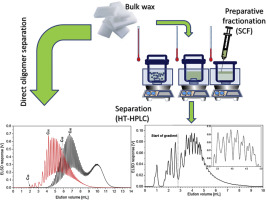当前位置:
X-MOL 学术
›
Anal. Chim. Acta
›
论文详情
Our official English website, www.x-mol.net, welcomes your feedback! (Note: you will need to create a separate account there.)
A Multidimensional Fractionation Protocol for the Oligomer Analysis of Oxidized Waxes
Analytica Chimica Acta ( IF 6.2 ) Pub Date : 2018-10-01 , DOI: 10.1016/j.aca.2018.03.007 Anthony Ndiripo , Harald Pasch
Analytica Chimica Acta ( IF 6.2 ) Pub Date : 2018-10-01 , DOI: 10.1016/j.aca.2018.03.007 Anthony Ndiripo , Harald Pasch

|
Oxidized waxes possess far superior properties as compared to the alkanes they are derived from. The separation of alkane oligomers via gas chromatography (GC) becomes a challenge when polar oxygen-containing functional groups are introduced or when higher molar masses are targeted. In the present study, the separation and analysis of oligomers in oxidized and non-oxidized waxes using different liquid chromatographic techniques are investigated. Oligomers in two oxidized waxes and a non-oxidized wax from which they are derived, are separated using high-temperature solvent gradient interaction chromatography (HT-SGIC) and high-temperature two-dimensional liquid chromatography (HT-2D-LC). Evaporative light scattering detector conditions are tailored to provide the best detection with the solvent system at use. It is shown that oligomers in oxidized and non-oxidized waxes can be separated and identified using the mentioned techniques. It has been found that the ELSD detector response systematically decreases as the oxidation levels of the waxes increase. Coupling of HT-HPLC and high-temperature size exclusion chromatography (HT-SEC) in a comprehensive 2D-LC setup shows a broadening of the molar mass distributions of the lower oligomer fractions as a consequence of the modification indicating changes in the oligomer chain microstructures. A preparative fractionation technique is utilized to collect specific oligomer fractions from the bulk waxes followed by hyphenation to HT-HPLC and other techniques. HPLC is shown to provide more detailed information on the oligomer composition of waxes when coupled to a pre-fractionation technique.
中文翻译:

氧化蜡低聚物分析的多维分馏方案
氧化蜡与衍生它们的烷烃相比具有远为优越的性能。当引入极性含氧官能团或以更高摩尔质量为目标时,通过气相色谱 (GC) 分离烷烃低聚物成为一项挑战。在本研究中,研究了使用不同液相色谱技术分离和分析氧化蜡和非氧化蜡中的低聚物。使用高温溶剂梯度相互作用色谱 (HT-SGIC) 和高温二维液相色谱 (HT-2D-LC) 分离两种氧化蜡和衍生它们的非氧化蜡中的低聚物。蒸发光散射检测器条件经过定制,可在使用的溶剂系统中提供最佳检测。结果表明,氧化蜡和非氧化蜡中的低聚物可以使用上述技术进行分离和鉴定。已经发现,随着蜡的氧化水平增加,ELSD 检测器响应系统性地降低。HT-HPLC 和高温尺寸排阻色谱 (HT-SEC) 在综合 2D-LC 设置中的耦合显示较低低聚物部分的摩尔质量分布变宽,这是表明低聚物链微观结构发生变化的修饰的结果. 使用制备分馏技术从大量蜡中收集特定的低聚物馏分,然后与 HT-HPLC 和其他技术联用。当与预分馏技术相结合时,HPLC 可提供有关蜡低聚物组成的更详细信息。
更新日期:2018-10-01
中文翻译:

氧化蜡低聚物分析的多维分馏方案
氧化蜡与衍生它们的烷烃相比具有远为优越的性能。当引入极性含氧官能团或以更高摩尔质量为目标时,通过气相色谱 (GC) 分离烷烃低聚物成为一项挑战。在本研究中,研究了使用不同液相色谱技术分离和分析氧化蜡和非氧化蜡中的低聚物。使用高温溶剂梯度相互作用色谱 (HT-SGIC) 和高温二维液相色谱 (HT-2D-LC) 分离两种氧化蜡和衍生它们的非氧化蜡中的低聚物。蒸发光散射检测器条件经过定制,可在使用的溶剂系统中提供最佳检测。结果表明,氧化蜡和非氧化蜡中的低聚物可以使用上述技术进行分离和鉴定。已经发现,随着蜡的氧化水平增加,ELSD 检测器响应系统性地降低。HT-HPLC 和高温尺寸排阻色谱 (HT-SEC) 在综合 2D-LC 设置中的耦合显示较低低聚物部分的摩尔质量分布变宽,这是表明低聚物链微观结构发生变化的修饰的结果. 使用制备分馏技术从大量蜡中收集特定的低聚物馏分,然后与 HT-HPLC 和其他技术联用。当与预分馏技术相结合时,HPLC 可提供有关蜡低聚物组成的更详细信息。



























 京公网安备 11010802027423号
京公网安备 11010802027423号